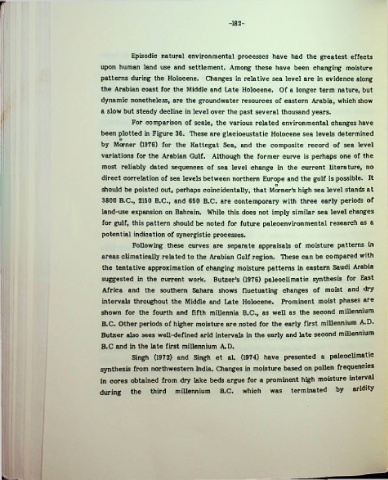Page 206 - Life & Land Use on the Bahrain Islands (Curtis E Larsen)
P. 206
rr
-182-
Episodic natural environmental processes have had the greatest effects
upon human land use and settlement. Among these have been changing moisture
patterns during the Holocene. Changes in relative sea level are in evidence along
the Arabian coast for the Middle and Late Holocene. Of a longer term nature, but
dynamic nonetheless, are the groundwater resources of eastern Arabia, which show
a slow but steady decline in level over the past several thousand years.
For comparison of scale, the various related environmental changes have
been plotted in Figure 36. TTiese are glacioeustatic Holocene sea levels determined
It
by Morner (1976) for the Kattegat Sea, and the composite record of sea level
variations for the Arabian Gulf. Although the former curve is perhaps one of the
most reliably dated sequences of sea level change in the current literature, no
direct correlation of sea levels between northern Europe and the gulf is possible. It
n
should be pointed out, perhaps coincidentally, that Morner’s high sea level stands at
3800 B.C., 2150 B.C., and 650 B.C. are contemporary with three early periods of
land-use expansion on Bahrain. While this does not imply similar sea level changes
for gulf, this pattern should be noted for future paleoenviron mental research as a
potential indication of synergistic processes.
Following these curves are separate appraisals of moisture patterns in
areas climatically related to the Arabian Gulf region. These can be compared with
the tentative approximation of changing moisture patterns in eastern Saudi Arabia
suggested in the current work. Butzer's (1976) paleoclimatic synthesis for East
Africa and the southern Sahara shows fluctuating changes of moist and dry
intervals throughout the Middle and Late Holocene. Prominent moist phases are
shown for the fourth and fifth millennia B.C., as well as the second millennium
B.C. Other periods of higher moisture are noted for the early first millennium A.D.
Butzer also sees well-defined arid intervals in the early and late second millennium
B.C and in the late first millennium A.D.
Singh (1972) and Singh et al. (1974) have presented a paleoclimatic
synthesis from northwestern India. Changes in moisture based on pollen frequencies
in cores obtained from dry lake beds argue for a prominent high moisture interval
during the third millennium B.C. which was terminated by aridity

